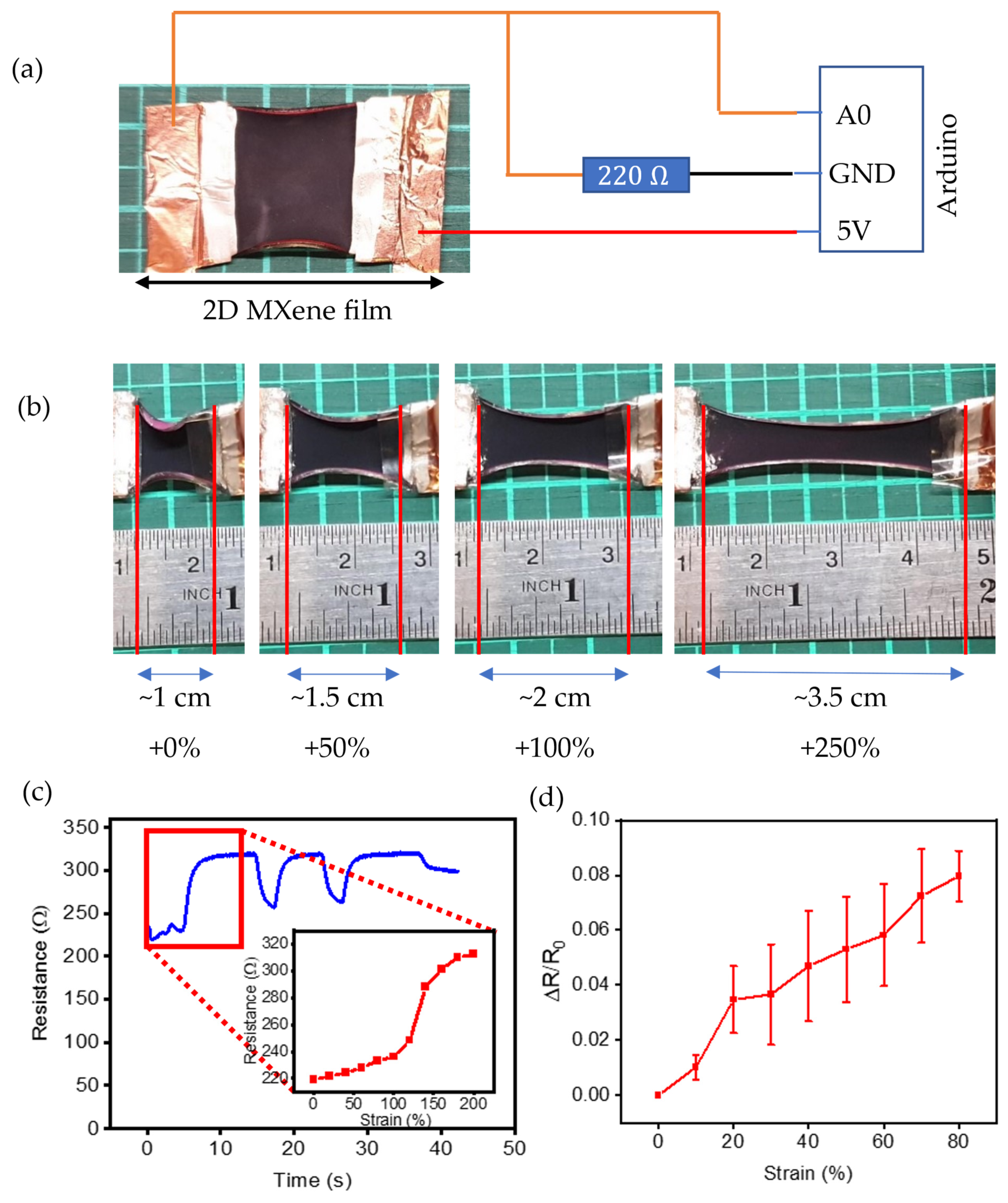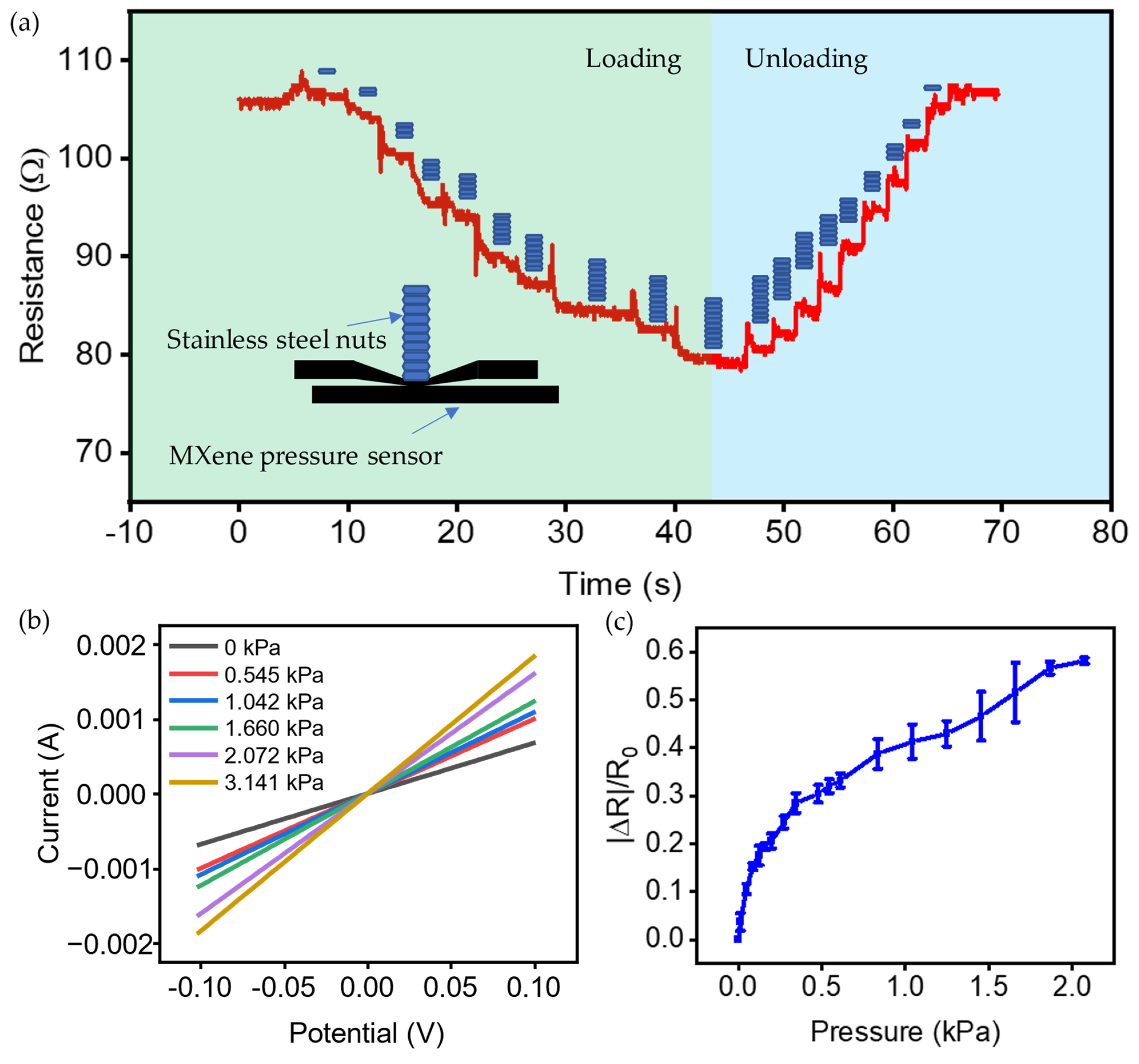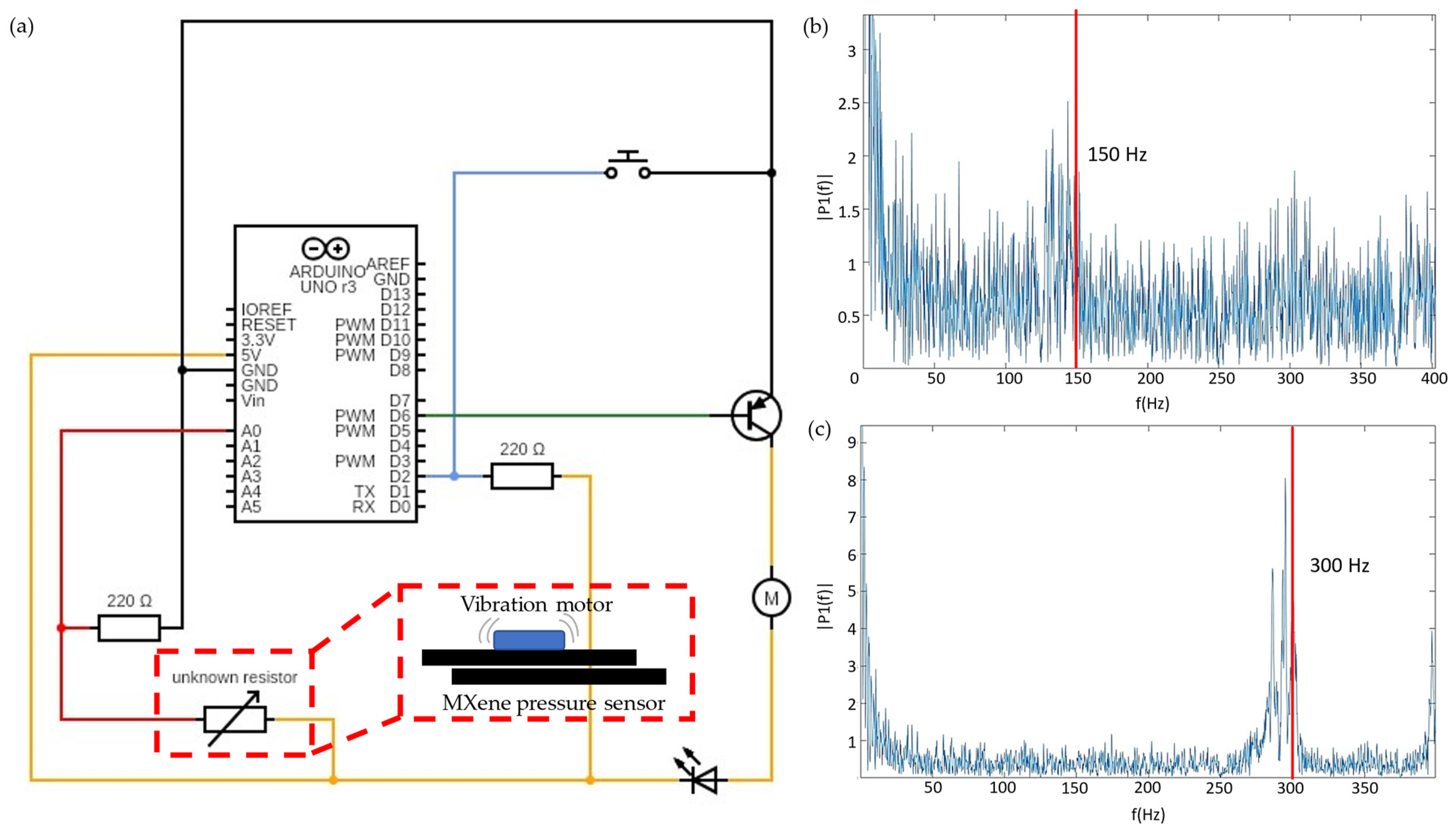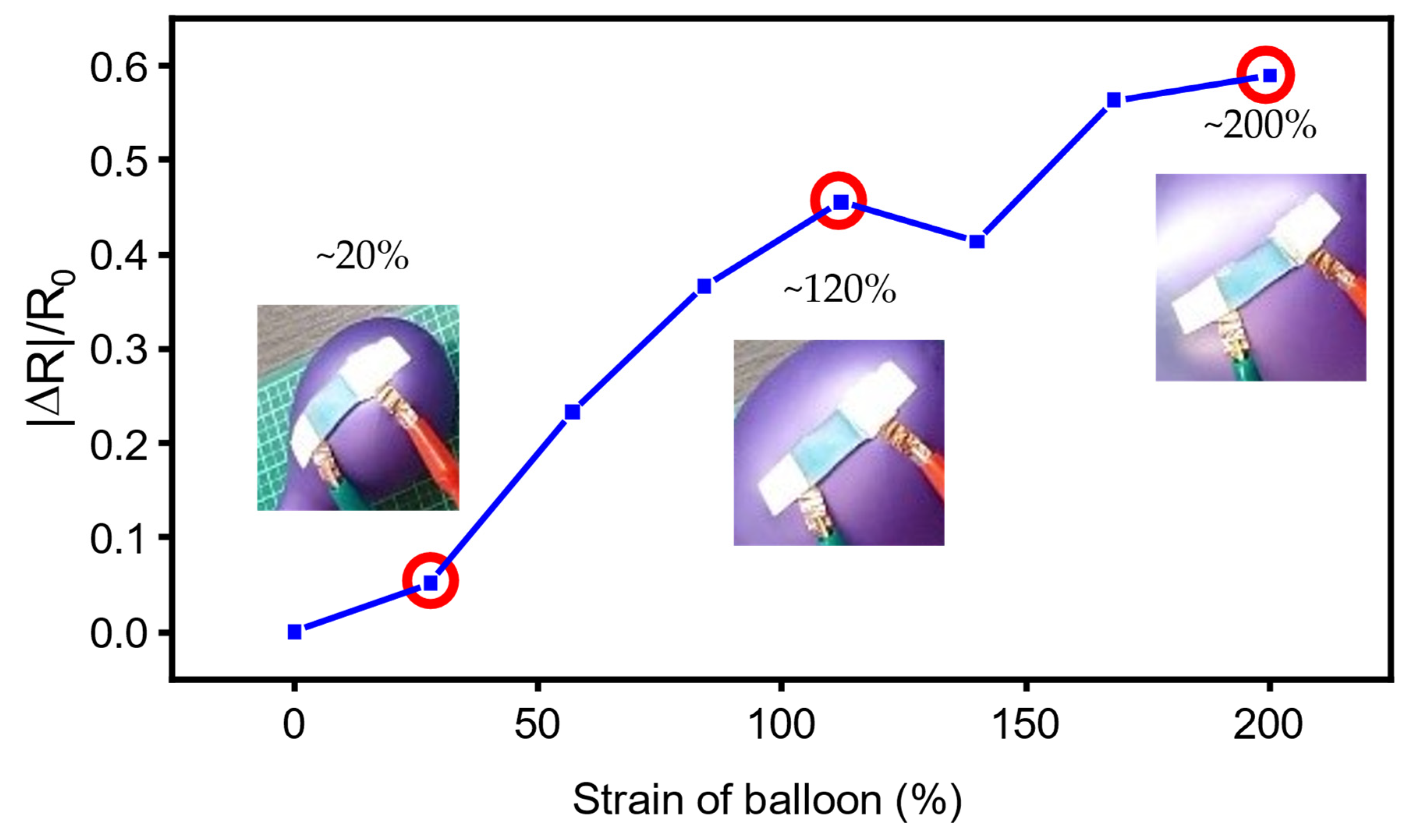Stretchable and Compliant Sensing of Strain, Pressure and Vibration of Soft Deformable Structures
Abstract
:1. Introduction
2. Materials and Methods
3. Results
3.1. Strain Response
3.2. Pressure Response
3.3. Vibration Frequency Response
3.4. Mounting on Balloon
4. Discussion
Author Contributions
Funding
Data Availability Statement
Conflicts of Interest
References
- Li, J.; Seng, Y.B.; Ponraj, G.; Kumar, K.S.; Cai, C.J.; Ren, H. Kirigami Strain Sensing on Balloon Catheters with Temporary Tattoo Paper. In Proceedings of the 2021 IEEE 17th International Conference on Wearable and Implantable Body Sensor Networks (BSN), Athens, Greece, 27–30 July 2021; IEEE: Washington, DC, USA, 2021; pp. 1–4. [Google Scholar]
- Chang, T.H.; Tian, Y.; Li, C.; Gu, X.; Li, K.; Yang, H.; Sanghani, P.; Lim, C.M.; Ren, H.; Chen, P.Y. Stretchable Graphene Pressure Sensors with Shar-Pei-like Hierarchical Wrinkles for Collision-Aware Surgical Robotics. ACS Appl. Mater. Interfaces 2019, 11, 10226–10236. [Google Scholar] [CrossRef] [PubMed]
- Dupont, P.E.; Simaan, N.; Choset, H.; Rucker, C. Continuum Robots for Medical Interventions. Proc. IEEE 2022, 110, 847–870. [Google Scholar] [CrossRef]
- Kumar, K.S.; Zhang, L.; Kalairaj, M.S.; Banerjee, H.; Xiao, X.; Jiayi, C.C.; Huang, H.; Lim, C.M.; Ouyang, J.; Ren, H. Stretchable and Sensitive Silver Nanowire-Hydrogel Strain Sensors for Proprioceptive Actuation. ACS Appl. Mater. Interfaces 2021, 13, 37816–37829. [Google Scholar] [CrossRef] [PubMed]
- Yang, J.; Ye, Y.; Li, X.; Lü, X.; Chen, R. Flexible, conductive, and highly pressure-sensitive graphene-polyimide foam for pressure sensor application. Compos. Sci. Technol. 2018, 164, 187–194. [Google Scholar] [CrossRef]
- Liu, Y.; Pharr, M.; Salvatore, G.A. Lab-on-skin: A review of flexible and stretchable electronics for wearable health monitoring. ACS Nano 2017, 11, 9614–9635. [Google Scholar] [CrossRef] [PubMed]
- Chortos, A.; Liu, J.; Bao, Z. Pursuing prosthetic electronic skin. Nat. Mater. 2016, 15, 937–950. [Google Scholar] [CrossRef] [PubMed]
- Hammock, M.L.; Chortos, A.; Tee, B.C.K.; Tok, J.B.H.; Bao, Z. 25th anniversary article: The evolution of electronic skin (E-Skin): A brief history, design considerations, and recent progress. Adv. Mater. 2013, 25, 5997–6038. [Google Scholar] [CrossRef] [PubMed]
- Zang, J.; Ryu, S.; Pugno, N.; Wang, Q.; Tu, Q.; Buehler, M.J.; Zhao, X. Multifunctionality and control of the crumpling and unfolding of large-area graphene. Nat. Mater. 2013, 12, 321–325. [Google Scholar] [CrossRef] [PubMed] [Green Version]
- Wang, Q.; Zhao, X. Beyond wrinkles: Multimodal surface instabilities for multifunctional patterning. MRS Bull. 2016, 41, 115–122. [Google Scholar] [CrossRef] [Green Version]
- Chen, W.; Gui, X.; Liang, B.; Yang, R.; Zheng, Y.; Zhao, C.; Li, X.; Zhu, H.; Tang, Z. Structural Engineering for High Sensitivity, Ultrathin Pressure Sensors Based on Wrinkled Graphene and Anodic Aluminum Oxide Membrane. ACS Appl. Mater. Interfaces 2017, 9, 24111–24117. [Google Scholar] [CrossRef] [PubMed]
- Jung, W.B.; Cho, K.M.; Lee, W.-K.K.; Odom, T.W.; Jung, H.T. Universal method for creating hierarchical wrinkles on thin-film surfaces. ACS Appl. Mater. Interfaces 2018, 10, 1347–1355. [Google Scholar] [CrossRef] [PubMed]
- Khang, D.; Rogers, J.A.; Lee, H.H. Mechanical buckling: Mechanics, metrology, and stretchable electronics. Adv. Funct. Mater. 2009, 19, 1526–1536. [Google Scholar] [CrossRef]
- Chen, P.Y.; Sodhi, J.; Qiu, Y.; Valentin, T.M.; Steinberg, R.S.; Wang, Z.; Hurt, R.H.; Wong, I.Y. Multiscale Graphene Topographies Programmed by Sequential Mechanical Deformation. Adv. Mater. 2016, 28, 3564–3571. [Google Scholar] [CrossRef]
- Chen, P.Y.; Liu, M.; Wang, Z.; Hurt, R.H.; Wong, I.Y. From Flatland to Spaceland: Higher Dimensional Patterning with Two-Dimensional Materials. Adv. Mater. 2017, 29, 1605096. [Google Scholar] [CrossRef] [PubMed]
- Hu, X.; Dou, Y.; Li, J.; Liu, Z. Buckled Structures: Fabrication and Applications in Wearable Electronics. Small 2019, 15, 1804805. [Google Scholar] [CrossRef] [PubMed]
- Tan, Y.; Chu, Z.; Jiang, Z.; Hu, T.; Li, G.; Song, J. Gyrification-Inspired Highly Convoluted Graphene Oxide Patterns for Ultralarge Deforming Actuators. ACS Nano 2017, 11, 6843–6852. [Google Scholar] [CrossRef] [PubMed]
- Jing, L.; Xie, Q.; Li, H.; Li, K.; Yang, H.; Ng, P.L.P.; Li, S.; Li, Y.; Teo, E.H.T.; Wang, X.; et al. Multigenerational Crumpling of 2D Materials for Anticounterfeiting Patterns with Deep Learning Authentication. Matter 2020, 3, 2160–2180. [Google Scholar] [CrossRef]
- Song, J.; Tan, Y.; Chu, Z.; Xiao, M.; Li, G.; Jiang, Z.; Wang, J.; Hu, T. Hierarchical Reduced Graphene Oxide Ridges for Stretchable, Wearable, and Washable Strain Sensors. ACS Appl. Mater. Interfaces 2019, 11, 1283–1293. [Google Scholar] [CrossRef]
- Pang, J.; Mendes, R.G.; Bachmatiuk, A.; Zhao, L.; Ta, H.Q.; Gemming, T.; Liu, H.; Liu, Z.; Rummeli, M.H. Applications of 2D MXenes in energy conversion and storage systems. Chem. Soc. Rev. 2019, 48, 72–133. [Google Scholar] [CrossRef]
- Ma, Y.; Liu, N.; Li, L.; Hu, X.; Zou, Z.; Wang, J.; Luo, S.; Gao, Y. A highly flexible and sensitive piezoresistive sensor based on MXene with greatly changed interlayer distances. Nat. Commun. 2017, 8, 1207. [Google Scholar] [CrossRef] [PubMed]
- Li, H.; Du, Z. Preparation of a highly sensitive and stretchable strain sensor of MXene/silver nanocomposite-based yarn and wearable applications. ACS Appl. Mater. Interfaces 2019, 11, 45930–45938. [Google Scholar] [CrossRef] [PubMed]
- Chang, T.H.; Zhang, T.; Yang, H.; Li, K.; Tian, Y.; Lee, J.Y.; Chen, P.Y. Controlled crumpling of two-dimensional titanium carbide (MXene) for highly stretchable, bendable, efficient supercapacitors. ACS Nano 2018, 12, 8048–8059. [Google Scholar] [CrossRef]
- Cao, Y.; Guo, Y.; Chen, Z.; Yang, W.; Li, K.; He, X.; Li, J. Highly sensitive self-powered pressure and strain sensor based on crumpled MXene film for wireless human motion detection. Nano Energy 2022, 92, 106689. [Google Scholar] [CrossRef]
- Tao, L.Q.; Zhang, K.N.; Tian, H.; Liu, Y.; Wang, D.Y.; Chen, Y.Q.; Yang, Y.; Ren, T.L. Graphene-Paper Pressure Sensor for Detecting Human Motions. ACS Nano 2017, 11, 8790–8795. [Google Scholar] [CrossRef]
- Tian, H.; Shu, Y.; Wang, X.F.; Mohammad, M.A.; Bie, Z.; Xie, Q.Y.; Li, C.; Mi, W.T.; Yang, Y.; Ren, T.L. A graphene-based resistive pressure sensor with record-high sensitivity in a wide pressure range. Sci. Rep. 2015, 5, 8603. [Google Scholar] [CrossRef] [Green Version]
- Yao, H.; Yang, W.; Cheng, W.; Tan, Y.J.; See, H.H.; Li, S.; Ali, H.P.A.; Lim, B.Z.H.; Liu, Z.; Tee, B.C.K. Near-hysteresis-free soft tactile electronic skins for wearables and reliable machine learning. Proc. Natl. Acad. Sci. USA 2020, 117, 25352–25359. [Google Scholar] [CrossRef]
- An, J.; Ma, Y.; He, M.; Yan, J.; Zhang, C.; Li, X.; Shen, P.; Luo, S.; Gao, Y. A wearable and highly sensitive textile-based pressure sensor with Ti3C2Tx nanosheets. Sens. Actuators A Phys. 2020, 311, 112081. [Google Scholar] [CrossRef]
- Guo, Y.; Zhong, M.; Fang, Z.; Wan, P.; Yu, G. A wearable transient pressure sensor made with MXene nanosheets for sensitive broad-range human–machine interfacing. Nano Lett. 2019, 19, 1143–1150. [Google Scholar] [CrossRef] [PubMed]
- Tannarana, M.; Solanki, G.K.; Bhakhar, S.A.; Patel, K.D.; Pathak, V.M.; Pataniya, P.M. 2D-SnSe2 nanosheet functionalized piezo-resistive flexible sensor for pressure and human breath monitoring. ACS Sustain. Chem. Eng. 2020, 8, 7741–7749. [Google Scholar] [CrossRef]
- Wu, Y.; Karakurt, I.; Beker, L.; Kubota, Y.; Xu, R.; Ho, K.Y.; Zhao, S.; Zhong, J.; Zhang, M.; Wang, X. Piezoresistive stretchable strain sensors with human machine interface demonstrations. Sens. Actuators A Phys. 2018, 279, 46–52. [Google Scholar] [CrossRef]
- Yan, J.; Ma, Y.; Li, X.; Zhang, C.; Cao, M.; Chen, W.; Luo, S.; Zhu, M.; Gao, Y. Flexible and high-sensitivity piezoresistive sensor based on MXene composite with wrinkle structure. Ceram. Int. 2020, 46, 23592–23598. [Google Scholar] [CrossRef]
- Yang, T.; Xie, D.; Li, Z.; Zhu, H. Recent advances in wearable tactile sensors: Materials, sensing mechanisms, and device performance. Mater. Sci. Eng. R Rep. 2017, 115, 1–37. [Google Scholar] [CrossRef]





| Active Material | Working Mode | Working Range | Sensitivity | Response/Recovery Time | Frequency Tested at | Ref. |
|---|---|---|---|---|---|---|
| Ti3C2Tx-textile | Pressure | <5 kPa | 19.78 kPa−1 | 149 ms/139 ms | ~3.3 Hz | [28] |
| MXene nanosheet | Pressure | 10.2 Pa −30 kPa | 2.52 kPa−1 (10–30 kPa) | 11 ms/- | 5 Hz | [29] |
| Paper-based SnSe2 | Pressure | 2–100 kPa | 1.79 kPa−1 | 100 ms/- | Finger tapping (~0.5 Hz) | [30] |
| Wrinkle-crumple reduced graphene oxide (rGO) | Pressure | 0.5–4 kPa | 0.055 kPa−1 (>50% strain) | 100 ms/100 ms (>50% strain) | 5 Hz | [2] |
| Patterned porous graphite | Pressure | <4 kPa | 0.088 kPa−1 | 100 ms/- | 1 Hz −400 Hz | [31] |
| Human skin | Pressure | - | - | - | 1–300 Hz | [6] |
| Wrinkled MXene | Pressure | 0–2 kPa | 0.935 kPa−1 0.188 kPa−1 | 250 ms/400 ms | 25 Hz −300 Hz | This paper |
Publisher’s Note: MDPI stays neutral with regard to jurisdictional claims in published maps and institutional affiliations. |
© 2022 by the authors. Licensee MDPI, Basel, Switzerland. This article is an open access article distributed under the terms and conditions of the Creative Commons Attribution (CC BY) license (https://creativecommons.org/licenses/by/4.0/).
Share and Cite
Yeo, D.Z.H.; Cai, C.J.; Chen, P.-Y.; Ren, H. Stretchable and Compliant Sensing of Strain, Pressure and Vibration of Soft Deformable Structures. Robotics 2022, 11, 146. https://doi.org/10.3390/robotics11060146
Yeo DZH, Cai CJ, Chen P-Y, Ren H. Stretchable and Compliant Sensing of Strain, Pressure and Vibration of Soft Deformable Structures. Robotics. 2022; 11(6):146. https://doi.org/10.3390/robotics11060146
Chicago/Turabian StyleYeo, Darren Zi Hian, Catherine Jiayi Cai, Po-Yen Chen, and Hongliang Ren. 2022. "Stretchable and Compliant Sensing of Strain, Pressure and Vibration of Soft Deformable Structures" Robotics 11, no. 6: 146. https://doi.org/10.3390/robotics11060146





